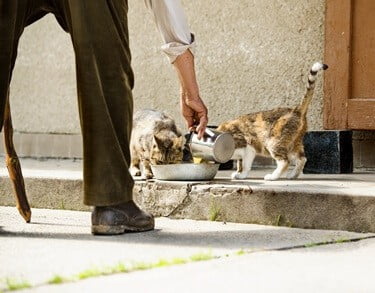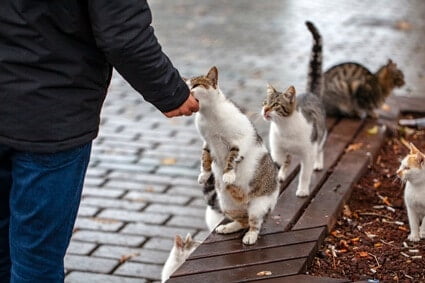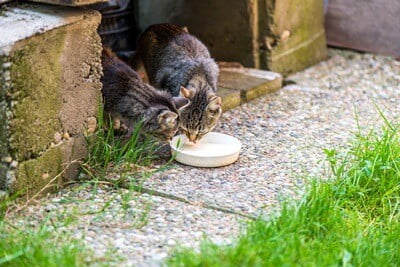Stray cats lead tough lives, so it’s natural to want to provide food whenever you see them. However, cats will keep coming back once you feed them, which can annoy neighbors or make stray feeding illegal in some areas.
Feeding stray cats enables them to live a slightly more comfortable life. However, doing so will increase the local stray population, leading to other starving strays. Their hunting instincts will reduce the local wildlife population. Also, strays often carry diseases, which can be harmful to household pets and humans.
Instead, participate in a trap-neuter-release program to keep the stray population low. You can foster stray cats that aren’t feral and find them homes. Also, taking them to a shelter can result in medical care and vaccinations.
Is It Good To Feed Stray Cats?
Feeding strays instinctively feels like the right thing to do. All cats, whether they have homes or not, need love. Strays, being out in the wild, have a lot to deal with. From traffic to territorial fights with other cats, strays have a tough life.
It may come as a surprise that many animal welfare advocates recommend that we don’t feed strays. That’s because there are consequences to this action, even if it appears to be the right thing to do. Feeding a stray not only impacts the other homeless cats in your area, but it has implications for:
- Local wildlife
- Neighbors
- Animal shelters
- The local stray population
Is It A Bad Idea To Feed Stray Cats?
Most people feel that feeding strays is a good deed. In many respects, it’s true because you’re helping a hungry cat to survive. However, feeding a stray doesn’t always have positive ramifications. There are many reasons to avoid feeding them, and even animal welfare groups and veterinarians advise against doing so.
Dangers Of Feeding Stray Cats
That’s because giving food to strays carries certain dangers, including:
Increase Population
The main issue is that giving food to strays increases their population. The more that they’re fed, the faster they’ll multiply. Adult females have about 2-3 litters per year.
Estimates show that a single adult female cat and subsequent kittens can produce up to 420,000 cats in 7 years. That means that you’re exacerbating the problem, creating more feral cats in need of care.
Affects Local Wildlife
Free-ranging cat populations affect local wildlife in devastating ways. According to Nature Communications, stray cats kill an estimated 1.3-4 million birds and 6.3-22.3 billion mammals annually in the United States.
Likewise, according to Global Change Biology, researchers have determined that feral cats are responsible for at least 14% of global bird, mammal, and reptile extinctions.
Local wildlife populations won’t just dwindle. They may even be hunted out of existence. Additionally, researchers determined that feral cats are the main threat to 8% of critically endangered birds, mammals, and reptiles.
Of course, not all of these cats are strays. Some of them are domesticated but allowed to roam outside. Nonetheless, researchers noted that un-owned cats cause the majority of deaths.
Carry Disease
Many people refuse to feed or go near strays. They’re exposed to more viruses and bacteria and, since they’re not cared for, their immune systems are also less effective. This means that they may become ill and pass on what’s making them sick to humans. Even if they’re not actively ill, they may be unwitting carriers of sickness and disease.
To cap it off, strays are often riddled with fleas. They’re likely to harbor worms and other parasites due to wild feeding. In some cases, they may carry rabies because they haven’t been vaccinated.
Feeding the cats won’t resolve these issues, as they’ll still be exposed to (and hunt in) wild environments. Unless they’re adopted, tamed, vaccinated, and given medical attention, there’s no way around this problem.
Bother Neighbors
You want to feed stray cats, but your neighbors are against the idea. That could be for good reason. Diseases, harming wildlife, and adding to the number of strays in the area can deter entire communities from feeding them. What’s more, strays can be loud and disruptive, digging up gardens and harming household pets.
Feeding strays means that they’ll come back. Like most creatures (even wild or feral animals), they’ll prefer an easy meal over one they need to hunt. With a reliable source of food, stray cats will almost certainly return. This can lead to them establishing colonies close to your home and overflowing into your neighbor’s property.
Alternatives To Feeding Stray Cats
This doesn’t automatically mean that you should stop feeding strays. Refusing to offer food is just one means of curbing the growth of the local stray population.
There are several more direct ways to assist strays and improve their lives. If you want to feed strays in your area, consider these tactics:

Support Trap-Neuter-Return Programs
Trap-neuter-return (TNR) is a common program run by animal rescue groups. This practice is an effective way of reducing stray populations without harming cats.
If you feed strays, you’re in a good position to support a TNR program. You know where strays congregate, and the population likely trusts you more than a total stranger. This makes it far easier to trap a stray and get it neutered.
Doing so ensures that taking care of one cat doesn’t lead to creating hundreds more. The stray, if it’s female, can also focus on improving its own survival. It won’t need to use nutrients, energy, time, and extra food to care for its young. This can keep the colony’s population low and help others stay healthier.
If possible, contact your local animal rescue group to see if they offer TNR. They likely have programs established that provide free or discounted neutering and vaccinations.
Foster Docile Strays
Fostering strays is time-consuming but rewarding. Getting a stray reintroduced and resocialized is a great way of improving a cat’s life. However, if you want to foster a cat, make sure it’s stray and not completely feral.
In technical terms, there’s a difference between a stray and a feral cat. Feral cats are those that have never been socialized with humans or have been socialized so long ago that they’ve forgotten it. On the other hand, strays are often cats that used to be family pets but aren’t anymore. Strays will eventually become feral.
All cats deserve love, protection, and respect. How that looks can be different based on if a cat’s stray or feral. Feral cats are better left alone for you and the cat’s safety. Feral cats have fully adjusted to living in the wild. Turning a feral cat into a household pet can be traumatizing and, in some cases, completely impossible.
True strays can be reintroduced back into domesticity, sometimes within weeks. Fostering a stray removes a cat from the street. You’re not just protecting the individual cat but reducing the number of strays in your local area.
Support Animal Shelters
Animal shelters are a tremendous force against the growth of stray populations. They keep cats sheltered, fed, and off the streets. Contact your local animal shelter to see how you can help. This may include helping strays to be re-homed, assisting in TNR, and caring for strays that the group is presently keeping.
Is Feeding Stray Cats Illegal?
The laws around feeding strays depend on the area you live. Some U.S. municipalities have made feeding strays illegal, and you can even be sentenced to jail time or pay a fine. If you want to feed a stray, check the local laws.
How Often Should I Feed Stray Cats?
If you’re committed to feeding stray cats, it’s legal in your area, and you pair it with some of the suggestions we’ve explored, you can feed strays as often as you like. Even one meal may mean that the cat revisits your home consistently in search of an easy meal. So, limiting the food won’t necessarily drive the cat away.
You can feed a stray cat every day, several times a day, or only when you think about it. It’s usually recommended to feed a stray cat once a day, either in the morning or evening. This will be the least destructive to a cat’s routine and allow it to hunt for the remainder of the day.
Allow the food to stay out for about 30 minutes. Cats may take turns eating, depending on their status in the social hierarchy. The more often you feed a cat, the more the stray will learn to trust you.
What Do You Feed Stray Cats?
Cat food is the best meal, whether or not it’s a stray. If you have cat food on hand, you can safely offer this to a homeless cat. There are alternative foods. Good sources of protein include:
- Chicken, beef, lamb
- Canned tuna
- Scrambled eggs
While less ideal, carbohydrates are a good way to add bulk to a stray’s meals. Cats are obligate carnivores and won’t process anything but meat effectively. However, food composed of vegetables is better than no food at all.
These meals won’t be the most filling, but they can tide a stray over until it finds more protein. They can also aid in digestion. Better sources of carbs for cats include:
- Plain boiled rice
- Sweet potato
- Pumpkin
Opt for low-sodium options and always cook any food that you give to cats.

How Much Should I Feed Stray Cats?
The amount of food a stray needs will depend on the nutrients in that food. If you provide whatever is available in your kitchen, it can be hard to determine portion sizes and the number of meals necessary.
Instead of weighing food, observe how much food is eaten when you feed the cat. Here are some basic guidelines:
- Is the food entirely consumed within 15 minutes> Do you need to add more?
- Is the food still uneaten after 30 minutes? If so, you’re giving it too much.
If you’re offering cat food, then portion sizes are easier to determine. Adult cats need 5.5 ounces of wet food or 2 ounces of dry food. Wet food tends to be more popular among cats due to its flavor and water content. However, dry food can be just as nutritious. It’s also easier to store.
Will A Stray Cat Starve If I Stop Feeding It?
There are times when you must stop feeding a stray cat. Perhaps you don’t have food to give, or you’re moving away and are concerned about the animal’s welfare. The good news is that the stray will be fine. If you stop feeding the cat, these resourceful animals will find other places to get food.
There Are Other Food Sources
If a stray comes to your door every day with a large appetite, it can feel like you’re its sole source of food. Most likely, this isn’t the case. Strays often have food sources other than you. It may prefer your meals, and it might have reserved its appetite for this feeding session, but it’s unlikely to be starving.
Cats are sensible creatures. They don’t rely on a single food source if they’re given the choice. Even in the wild, cats will hunt in many areas to ensure that one resource doesn’t dry up and leave them hungry.
Other food sources may not be as plentiful or as reliable, but they do exist. If you leave, that stray will show up at someone else’s door and have them provide food.
Strays Can Hunt
Stray cats are good hunters and may become a menace to local ecology.
Even domesticated cats have a natural instinct to catch birds, rats, and lizards. A stray cat may do this for fun, as well as to keep itself fed. Feral cats will be well-versed in this practice and rely on it for several meals.
As such, if you stop feeding strays, they can easily get food on their own. This food may come in the form of birds, mice, and other local wildlife.
Strays Can Survive
From a human perspective, it may seem like strays are completely dependent on us. However, this is far from the truth. Feral cats are actually better off when left alone in the wild as they have adjusted to living outdoors.
Of course, stray cats have tough lives, and their life expectancy is much shorter than that of pet cats. They still know how to fend for themselves, though. Even cats that aren’t completely feral can fend off dangers. After all, cats descended from wild ancestors, and they still have the genes and instincts that enable them to survive.
Will A Stray Cat Go Away If I Stop Feeding It?
If you stop feeding a stray cat altogether, it may continue to visit in the coming days and weeks. However, when it realizes that no more food is forthcoming, it’ll seek out other more reliable food sources.
Cats usually stake out a territory and rarely move away from their chosen space. It may be forced to hunt or seek out other people to feed it. However, the chances are, the cat is finding other sources of food near you.


Thank you for this information I’ve been feeding around 25 cats daily and people are getting upset with me.I have fixed 24 but about 5 haven’t come back.I ve been thinking about stopping feeding them but I feel so bad because I ve been doing it for year now.They know me they love to be pet,and I just can’t stop feeding them.After reading your article is giving me some type of comfort knowing that they know how to survive on their own.
I feel the same way
There was a cat who came to my apartment door a month ago looking thin and desperate for affection and food. I couldn’t resist it and decided to give the poor cat some food and it started to came in the front of my door daily. At the first I was happy giving some food to the innocent cat because I thought I was making its life easier (and also that cat loves to be petting which made me more happier), but sadly I started to realize how wrong I was. The neighbors started to complain to each other about the cat (they don’t know about me feeding it) my mother herself started to complain about the cat which was more than enough reason for me to stop feeding it because I can’t burden my nice neighbors neither my mom. I wanted to stop but every time that poor and pure cat looking at my eyes making it harder for me than it should. Then finally today I started to ignore/feeding (which was destroying my heart from inside…… And her desperate eyes couldn’t make me feel any better) but I know that I had to stop or one of my neighbors may hurt it besides the many problems its caused by staying around. And sadly there is no local shelter or vet near my area. So basically it was my fault from the very beginning for what I done to my neighbors by bothering them with the cat presence and for the poor cat by destroying its trust. I felt so guilty till I saw this article. So thank you very much for it and I hope that poor cat find someone who’s better than me by million times and find a safe warm home waiting for her inside.
Hi there, I’m staying in the five storey apartments. I’m feeding two domestic stray cats at my house compound with wet food always sometimes with dry food until i had not enough expenses for my own. I always thought that they could’nt find food for themselves. Until i read these article and watch the video. But yet i still have the same thought in my mind. When I’m stop feeding them . I was thinking that I should reduce the quantity of food I have for them daily. Expecting them to hunt food in other places for themselves .
I am so glad I read these comments. I was about to go out to feed the community cats. I have been providing them for almost two years, and I am getting so exhausted, and I want to stop, but I can not stop thinking they will starve to death. I adopted a few cats and one with a broken leg. Costly, way more than enough; my family started complaining that I needed to stop picking up stray cats. It is so hard for me to stop to feed them. They are almost 20 of them and leave by the wooded area where the restaurant has been closed for years, and not that many people come by to feed them. It will take a long time for me to forget their face and sit in the rain waiting for me to come by, but sadly some point, I do have to stop. Breaking my heart, same time glad I got some positive information. I am going to try hard to stop feeding them. Thank you to Senior cat wellness.
My neighbor passed away and left 10 “stray” cats. I have been feeding them once a day since May. One is sorta friendly letting me pet and scratch her. The Question is I can’t afford to do this forever and I am going on vacation. Since these cats are spoiled should I cut back feeding to every other day, then stop feeding all together. I live in the country but have close neighbors, these cats have been fixed (so far no one has dumped a new cat). I may see if I can trap the friendly one and take it a no kill shelter for a home.